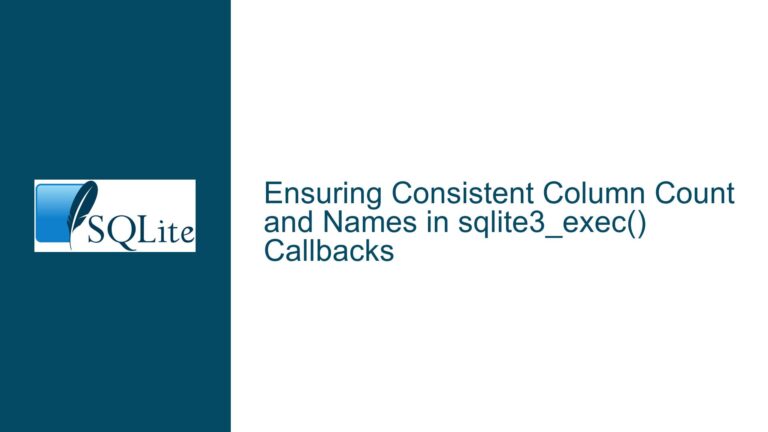Replacing Subqueries with Window Functions for Grouping in SQLite
Understanding the Grouping Challenge with Grouper and Member Rows
The core challenge involves categorizing sequential rows in a table based on the presence of a "grouper" marker. In the provided example, rows with the letter ‘C’ are designated as "grouper" entries, while all other rows are "member" entries. The goal is to group all "member" rows with the nearest preceding "grouper" row, forming contiguous segments of data. This is similar to creating session windows in time-series data or paragraph blocks in text processing.
Consider the input table letters:
| letter | pos | category |
|---|---|---|
| C | 1 | grouper |
| a | 2 | member |
| b | 3 | member |
| C | 4 | grouper |
| o | 5 | member |
| m | 6 | member |
| … | … | … |
The desired output groups rows into sequences starting with a "grouper" and including all subsequent "members" until the next "grouper" appears. For instance, the first group ("C", "a", "b") starts at position 1 (the first "grouper"), the next group ("C", "o", "m", "b") starts at position 4, and so on.
The initial solution used a correlated subquery to identify the most recent "grouper" position for each row:
SELECT
l.letter,
CASE
WHEN l.category = 'grouper' THEN l.pos
ELSE (
SELECT t.pos
FROM letters t
WHERE t.category = 'grouper' AND t.pos < l.pos
ORDER BY t.pos DESC
LIMIT 1
)
END AS grp
FROM letters l
ORDER BY l.pos;
While functional, this approach has inefficiencies. Correlated subqueries execute row-by-row, leading to O(n²) complexity in large datasets. Window functions offer a more elegant and performant solution by calculating groupings in a single pass over the data.
Common Pitfalls in Implementing Variable-Length Groups Using SQL
Misunderstanding Window Function Framing
A frequent mistake is assuming that window functions inherently partition data into fixed-size chunks. However, window functions operate over a "frame" defined relative to the current row. The default frame (e.g., ROWS BETWEEN UNBOUNDED PRECEDING AND CURRENT ROW) allows cumulative calculations but does not inherently reset at "grouper" rows.
Incorrect Use of Boolean Aggregation
SQLite treats boolean expressions as integers (1 for true, 0 for false). Developers unfamiliar with this behavior might not realize that SUM(category = 'grouper') is equivalent to counting the number of "grouper" rows. This misunderstanding leads to missed opportunities for leveraging cumulative sums as group identifiers.
Overlooking Frame Specification
Omitting explicit frame clauses (e.g., ROWS BETWEEN UNBOUNDED PRECEDING AND CURRENT ROW) can cause confusion about how values accumulate. While this is the default for some functions, explicitly defining the frame clarifies intent and ensures correctness across SQL implementations.
Confusing PARTITION BY with Cumulative Logic
The PARTITION BY clause resets calculations at partition boundaries, which is unnecessary here since groupings depend on sequential "grouper" positions rather than predefined categories. Attempting to partition by category would incorrectly split groups at every "grouper" instead of incrementing group IDs cumulatively.
Step-by-Step Guide to Window Function Solutions for Cumulative Grouping
Key Insight: Cumulative Sum of Grouper Flags
The correct approach uses a cumulative sum over the boolean expression category = 'grouper'. Each "grouper" increments the sum by 1, creating a unique group identifier that persists until the next "grouper":
SELECT
letter,
SUM(category = 'grouper') OVER (ORDER BY pos) AS grp
FROM letters;
This query produces:
| letter | grp |
|---|---|
| C | 1 |
| a | 1 |
| b | 1 |
| C | 2 |
| o | 2 |
| m | 2 |
| b | 2 |
| C | 3 |
| C | 4 |
| … | … |
Explanation:
SUM(category = 'grouper')counts the number of "grouper" rows up to and including the current row.- The
OVER (ORDER BY pos)clause ensures rows are processed in positional order. - Each "grouper" increments
grp, creating a new group ID.
Explicit Frame Specification for Clarity
While the default frame suffices, adding an explicit frame clarifies intent:
SELECT
letter,
SUM(category = 'grouper') OVER (
ORDER BY pos
ROWS BETWEEN UNBOUNDED PRECEDING AND CURRENT ROW
) AS grp
FROM letters;
Result: Identical output, but the frame definition makes it clear that the sum includes all preceding rows.
Alternative: COUNT with FILTER Clause
For SQL dialects supporting FILTER, this achieves the same result:
SELECT
letter,
COUNT(*) FILTER (WHERE category = 'grouper') OVER (ORDER BY pos) AS grp
FROM letters;
Note: SQLite does not support FILTER with COUNT(*), but SUM with a boolean expression is equivalent.
Final Grouping and Aggregation
With the group IDs calculated, aggregate the letters using GROUP_CONCAT:
SELECT
GROUP_CONCAT(letter, '') AS word
FROM (
SELECT
letter,
SUM(category = 'grouper') OVER (ORDER BY pos) AS grp
FROM letters
)
GROUP BY grp
ORDER BY grp;
Output:
word
----------
Cab
Comb
C
Cte
Calendar
Handling Edge Cases
- Consecutive Groupers: If two "grouper" rows appear consecutively (positions 8 and 9), the second "grouper" starts a new group with no members.
- No Leading Grouper: If the first row is a "member", the initial group ID will be 0. Adjust by adding
COALESCEor offsetting the sum.
Performance Considerations
- Complexity: The window function approach runs in O(n) time, outperforming the O(n²) correlated subquery.
- Indexing: Ensure
posis indexed if the base table is large, though thegenerate_seriesCTE in the example generates positions sequentially.
Debugging Tips
- Inspect Intermediate Results: Run the window function query without aggregation to verify group IDs.
- Validate Frame Boundaries: Test with explicit
RANGEorROWSclauses to ensure correct accumulation. - Check Boolean Casting: Verify that conditions like
category = 'grouper'return 1/0 using a subquery.
By mastering these techniques, developers can efficiently replace procedural logic with declarative SQL, leveraging window functions for complex grouping scenarios.






